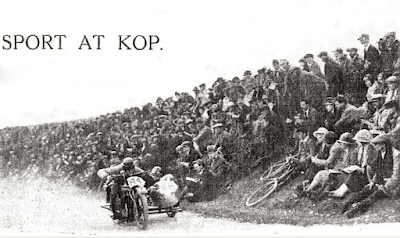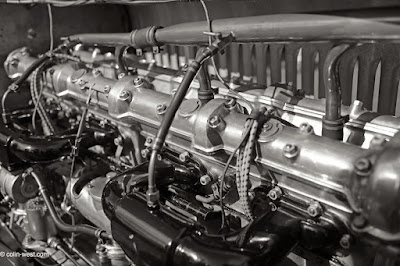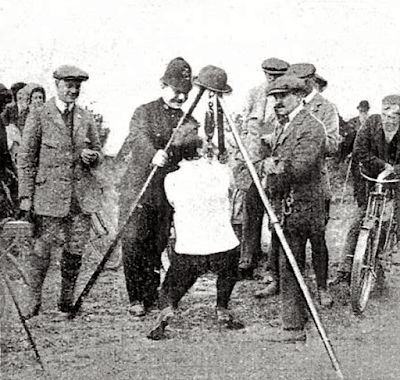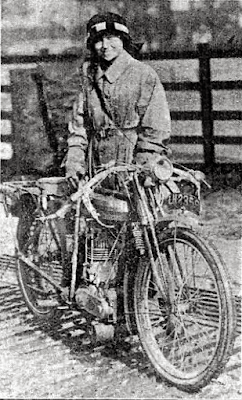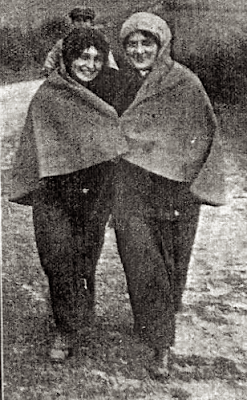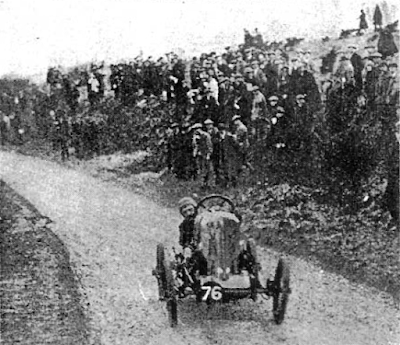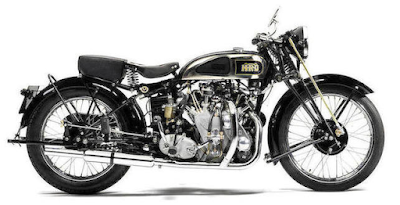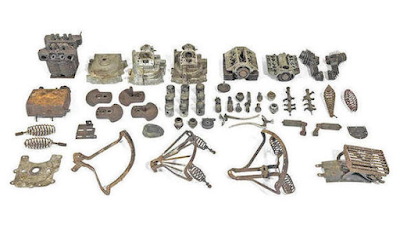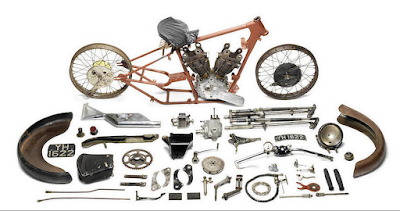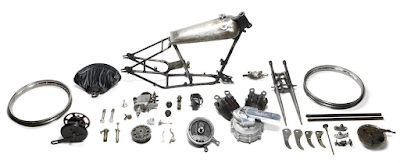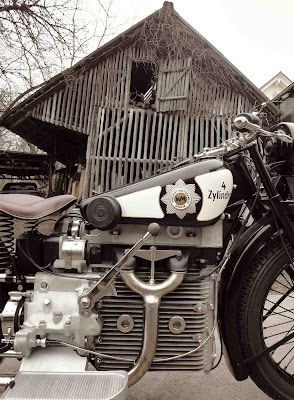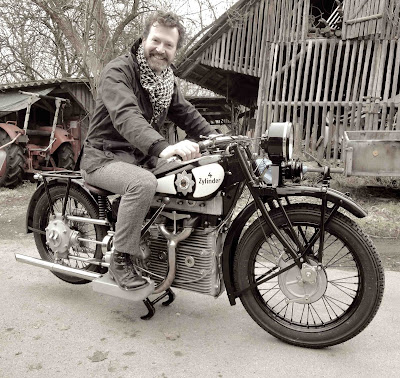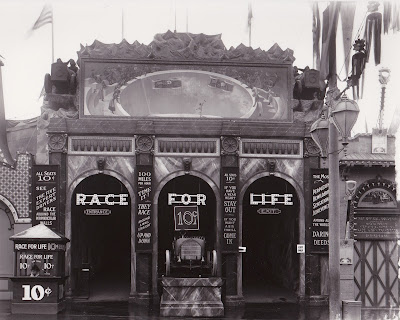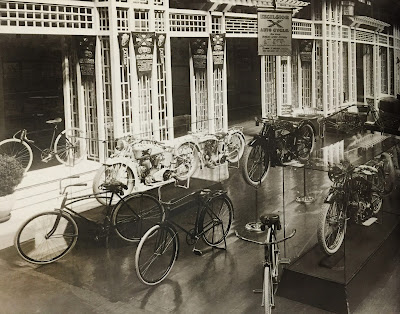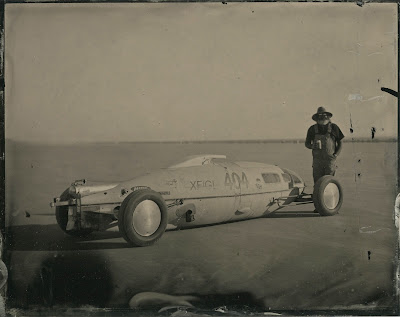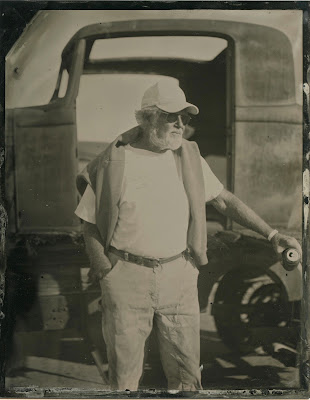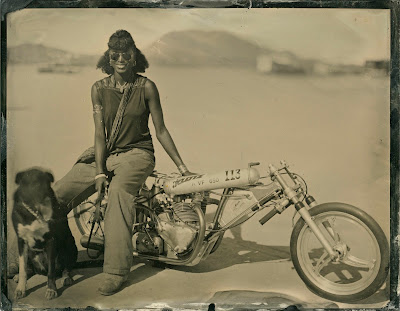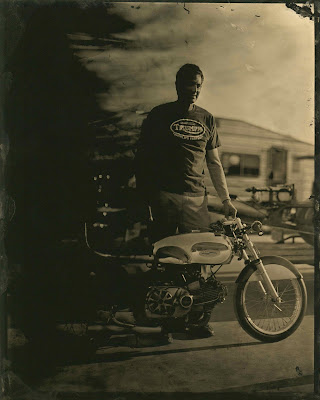(Originally published in CycleWorld.com)
![]() |
| My favorite machine of the week, a 5/8ths scale Indian board track racer, which runs! |
The Las Vegas motorcycle auctions, held early January for the past 25 years, are the 800lb gorilla of the collector bike market, setting benchmark prices as the whole world is watching.
This year over 1000 machines sat parked two hotels - Ballys for trad English
Bonhams auctions, and the
South Point Casino for the all-American
Mecum cattle drive, with a $30 cab ride separating the two.
Bring a bike or rent a car; it’s cheaper than cabbing from the Strip to the outerlands and back, because whether you stay in town or at the South Point, you’ll want to escape Las Vegas’ twilight interior netherworld at some point over 5 days.
This year I discovered a
hip sushi joint in old-town Fremont, with a Portlandish interior and actual fresh air entering through operable windows – exotic stuff on the Strip.
![]() |
| Malcolm Barber of Bonhams auctions an amazing original-paint 1930 Harley-Davidson with twin headlamps |
Full disclosure; I’m so in bed with both these auction houses it’s a scandal, with Bonhams the principal underwriter of my blog TheVintagent.com, and Mecum hiring me to provide ‘color’ during their auction and sportscast during their NBCSN broadcast.
![]() |
| More than one 1965 Triumph T120 Bonneville came under the hammer at Mecum, and this one sold for $14k. |
There seems to be no middle ground in the moto-auction world today; the line in the sand is $100k, which sets the truly collectible apart from the ordinary riffraff. The majority of bikes sell for under $30k (about the price of a new Harley dresser), while the fat-wallet boys push everything else into six figures, with almost nothing in between. Collecting bikes has become a two-tier system…which looks a whole lot like our current economy. Similarly, a small number of buyers dominated the Vegas proceedings, snagging dozens of bikes over the week; some for resale, most to bolster already large collections. What’s the ideal size of a motorcycle collection? One more.
Here are 10 examples from this years’ auctions, which say a lot about the market, and what buyers think is hot or not.
![]() |
| One of a string of really nice '50s/60s British machines which sold for peanuts at Bonhams, all in original or 'rider' condition. This 1959 AJS Model 31 one looked to have a Von Dutch tank, but was a bargain in any case |
1.
1959 AJS Model 31: Bonhams had two dozen no-reserve ‘estate’ British singles and twins lined up at Ballys, none of which I would kick out of my garage. This one piqued my interest; the paint job and pinstriping looked suspiciously Von Dutch.
Close examination revealed a ‘Bates…60’ signature, but the grumpy pinstriper liked pseudonyms. A gaggle of Von Dutch collectors examined the tank, we all shrugged our shoulders and said ‘probably’, but it’s headed to England now, selling for $4830.
Clearly the Von Dutch craze has cooled.
More good news: 1950/60s/70s Britbikes are totally affordable, with original bikes fetching $4-8k at Bonhams, and restored versions hitting twice that at Mecum.
Bonnevilles, Commandos, and other twin-cylinder weekend riders have very stable prices.
![]() |
| Yes, it looks like a red Rapide, but No! It's really a white Shadow in red! Mind games are becoming very expensive in the old bike world...this bike had been modified for road use, with Mikuni carbs and Lightning brakes, etc. Someone enjoyed it, surely, but the price today... |
2.
1950 Vincent ‘White’ Shadow: Postwar Vincent twins have settled into a pattern; a Rapide model in good condition hovers around $45k, and its near-identical sister the Black Shadow costs two or three times that.
Unless it’s a ‘white’ Shadow, which looks like a Rapide but isn’t, and especially if it’s painted red, then you’re balls deep at $345k.
If that sounds confusing, you’re obviously not the sort to pay $1M for an ‘inverted Jenny’ postage stamp.
To explain; all Vincents are collectible, but not particularly rare – the company built around 7000 twins in 9 years after WW2, with a range of options.
Some options were rarely produced, like a Black Shadow with unpainted engine cases – colloquially called the ‘White’ Shadow.
The factory only sold one Series C Black Shadow with unpainted engine cases and red bodywork – the Red ‘White’ Shadow.
Vincent prices have become a geeky-greedy numbers game, based on hype and factory-records rarity.
Just like Musclecars.
![]() |
| Tasty! I'm certain this pre-unit TR6 custom sold for a record price for a Triumph custom not built by Von Dutch or owned by McQueen! |
3.
1959 Triumph TR6 Custom: I would never have recommended selling a custom motorcycle at Las Vegas – prices for customized Harley-Davidsons are embarrassingly low, with Brit customs much the same.
A lot of disappointed builders feel forced to drop their reserves, and sell for peanuts.
That said, this traditional Triumph bob-job had terrific attention to detail and an exceptional build quality; all boxes were ticked and it just looked right.
Several bidders at Mecum thought so too, duking it out for a full 5 minutes and driving the price to $34k including auction fees, but not sales tax.
That’s probably what the builder charged had into it, and I think this was a record for a Triumph custom not previously owned by Fonzie.
A bargain tweaked Triumph was a nutso twin-engine across the frame pre-unit ‘4’, at $23k.
Not reproducible at this price, and if one wanted to make a statement, this was an Oscar Wilde quip.
By double contrast, a sad ’59 T120 Bonneville ‘bobber’ in a rigid frame, with the droopy stance of a home-built special, fetched only $4300 at Bonhams, probably for its rare first-year powerplant.
![]() |
| Everybody wants one; so cute and sporty. In the real world, they're slow; it's only a 125cc from 1960 after all! The Honda Benly Super Sport if a masterpiece of design and engineering though... |
4.
1960 Honda Benly 125cc Super Sport: Always coveted for its racy looks and hot spec (it was the fastest 125 in the world), this lovely restored Benly cost someone $13,400, which seems a lot for such a small machine, but they’ve stabilized at this price for several years. Middle-aged dudes are also restoring Honda ‘Monkey Bikes’, which sell all day long for $4k. Non-4 cylinder Japanese bikes hover in the $3-8000 range, even if they’re totally restored, so that RD350 or H1 you covet is still affordable.
![]() |
| Two people really wanted this Confederate Wraith, so the price went sky high. I bet neither has actually ridden one! I have - while the engine is terrific and powerful, and the suspension works well, the handling around corners is really weird, and felt like the rear wheel was jacked up in corners. For showboating only, but what a looker. |
5.
2007 Confederate Wraith: Pretty much speechless at the $103,500 hammer on this one, which meant TWO bidders were determined to take it home.
Actually purchased by a German friend of mine, who texted, ‘As the Confederate flag is now forbidden in your country, I thought I would take the Confederate bike too.’
Very considerate, Helmut…I think.
Meanwhile in the real world, a ’99 Hellcat Roadster sold for $20,700.
![]() |
| Nobody thought this ex-McQueen Triumph desert sled would recoup its $85k purchase price at auction several years ago...but they were wrong! $103,500...people just want some Steve. |
6.
1963 Triumph Bonneville ‘desert sled’: Steve McQueen magic levitates cash from wallets, and this beautifully patinated dirt bike, complete with mid-level scrambler pipes and a leather Bates seat, broke the ton at $103,500.
I’m often asked ‘what’s the McQueen multiplier?’
In this case, its 1500%.
Hero worship is not rational, nor is it consistent; McQueen owned a whole lot of motorcycles, some of which he rode, and some are titled to his Solar Productions business; Lord knows who actually rode them, but McQueen on the title is good enough.
![]() |
| Okay, it's a big plastic slab, but exquisitely crafted and part of a long evolution of alternative motorcycle design. Purchased for peanuts; buy one now while the market is at rock bottom, the Bimota Tesi 1D is a whole lotta motorcycle. |
7.
1992 Bimota Tesi: The typical value curve of used motorcycles starts with a 20% hit the minute they leave the showroom, then a downward slide till they hit rock bottom at the 20 year mark.
Prices perk up as nostalgia kicks in, and far exceed the original price eventually, bringing them to the value of a new machine, or much more if the bike is rare or the object of universal lust. Bimotas are at the bottom of that curve right now, with ten perfect examples selling in Vegas as little as $7000 (a ’96 Mantra DB3) or $16,750 for the remarkable 1992 Tesi 1D.
Early Bimotas, the 1970s models, are well over $20k now, so if you’ve ever had a hankering for hand-crafted Italian road jewelry, pull the trigger soon.
![]() |
| Factory cutaways qualify as guilt-free sculpture, and sell for big money, like $110k for this '56 BSA Gold Star |
8.
1956 BSA Gold Star Cutaway Model: Herb Harris is best known for owning the most famous Vincents in the world at various times, including the Rollie Free ‘bathing suit’ record-breaker.
He’s also a keen collector of factory display-model cutaway engines and whole bikes, like this BSA Goldie built for the ’56 Earls Court Show, which is motorized for both engine and suspension function!
An intact ’56 Gold Star might cost $25k, but one cut up by factory apprentices set someone back $110,000.
That’s a fine art price for a non-rolling sculpture.
Herb’s cutaway Norton, Matchless and BSA engines fetched $5-8k, about the cost of a whole machine.
Are moto-sculptures worth so much more than an actual riding experience?
For whatever reason, the answer is yes.
![]() |
| Jet bike. Kerosene is cheap! Blow away your neighbors, and your leaves too! |
9.
2004 MTT Y2K Turbine: You CAN own a jet bike.
It would have cost you $115,000 at Mecum.
Jay Leno hilariously recounts melting a Subaru’s bumper at a stoplight with the exhaust from his MTT; you can melt bumpers too.
I recall a pair of MTT’s firing up in the forecourt of the Ritz hotel at the Legend of the Motorcycle Concours, then being shooed away by the staff; jets are powerful unburnt kerosene pumps.
1000% more obnoxious than an open-pipe Harley chopper.
![]() |
| Last of the American hot-rod Fours, a '29 Cleveland Tornado. The Depression killed off the last of the small American bike producers, leaving just Harley-Davidson and Indian...but we once had a thriving and fascinating industry |
10.
1929 Cleveland Tornado 4-cylinder: The fastest American motorcycle in ’29, good for 100mph, which is why their #1 customers were cops.
Prewar American fours are floating around the six-figure mark, and this bike sold for $115k.
Two other fours (Pierce and Henderson) were similar money at Mecum, and an Ace four at Bonhams was much the same.
If you want an early American multi, expect to pay $25k/cylinder.
![]() |
| Blink and you missed it! Working with the NBCSN crew on two broadcasts - sporstcasting for motorcycle auctions! It's fun work - this is Scott Hoke, Mecum's regular commentator on NBC, along with John Kraman |
